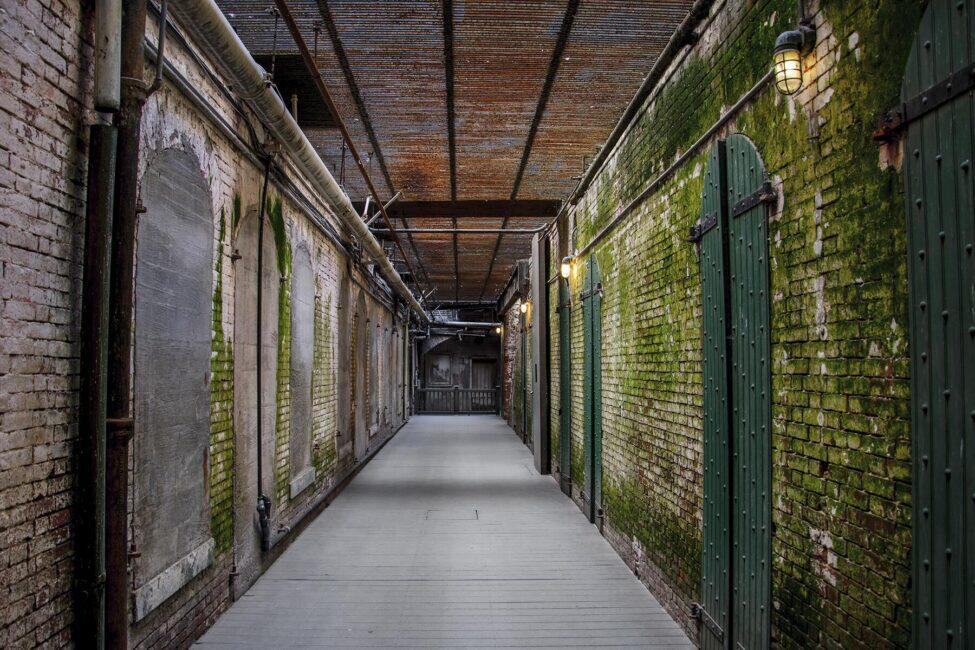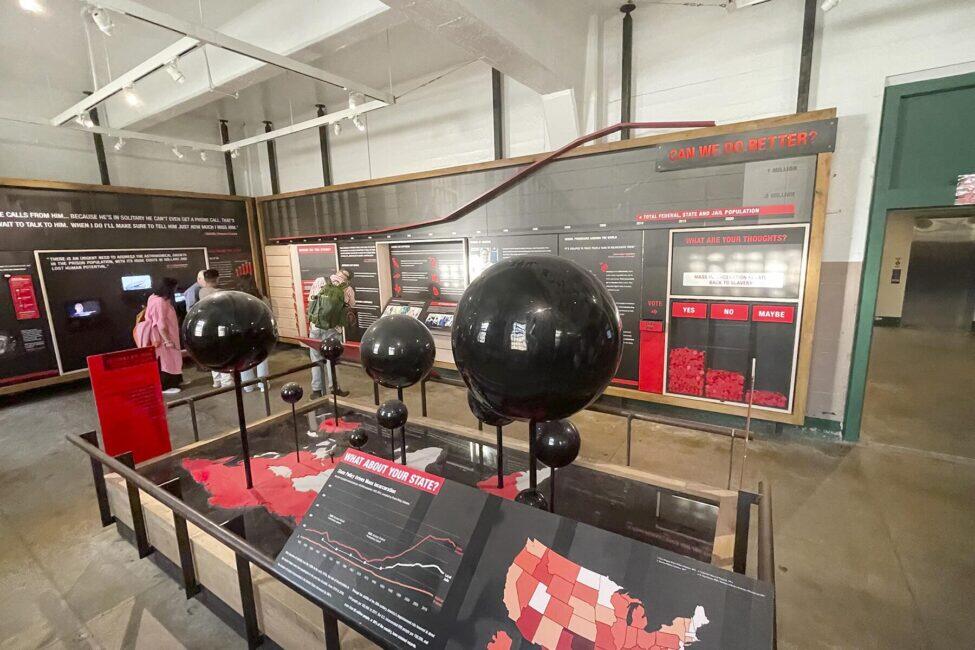Tours of Alcatraz were once focused on the lore of its criminals, but today tours of this ruthless prison explore deeper questions.
What is the price to pay for stealing $16.38? For Joe Bowers in the 1930s, his act resulted in a 25-year sentence on Alcatraz, one of the world’s most ruthless prisons.
“It was a federal offense because he stole it from a store that served as the community post office,” says associate director at Golden Gate National Parks Conservancy John Moran, who is leading the Alcatraz Night/Behind the Scenes Tour that I’m on. He explains that, originally, Bowers was sent to McNeill Island federal prison, in Washington, only to be transferred to Alcatraz for behavioral problems.
On future tours, Bowers’ larger-than-life story encompassed his notoriety as being the first man to try to escape from Alcatraz. The crowds lapped it up. But in 2000, the National Archives and Records Administration made the Alcatraz files open to the public, and a fuller story emerged, pointing to symptoms of mental illness.
“He tried to commit suicide in his [McNeill Island],” Moran says. “The doctors there said he didn’t cut his wrists really deeply; he was feigning this. So they sent him to Alcatraz, where he tried to commit suicide again, breaking his eyeglass lens to try to cut his throat. The determination was [that] it was just an attempt to get attention.”
Recommended Fodor’s Video
Then one day, Bowers climbed a fence in broad daylight near an armed guard who fired warning shots. When he didn’t get down, the guard killed him with a 30-caliber bullet. So was he the first guy to attempt to escape Alcatraz? Or was he suffering from mental illness?
“The latter is the story we tell today,” Moran says.
Alcatraz, occupying a lonely island in the middle of San Francisco Bay, originated as a Civil War fortress. In 1934, it was refortified into the world’s most secure prison, closing in 1963. Nearly a decade later, it became a national park and, in 1972, was incorporated into the Golden Gate National Recreation Area. Today, more than a million people a year visit the rocky isle with its dark, empty cells.
Now, questions are being asked about Alcatraz’s mode of justice and about the entire justice system in general.
As we walk along the road leading up to the cell house, I realize this tour is not like the ones I remember from decades ago when my family would come to visit. Then, it was all about the locked-up criminals, their chilly, minimalistic accommodations, and, above all, the drama of their escape attempts, immortalized by Hollywood—which will always be part of Alcatraz’s lore. But now, questions are being asked about Alcatraz’s mode of justice and about the entire justice system in general.
“We want to tell fascinating stories, but we need to connect them to something else,” Moran says.

The Dungeon
One of the places where we get a prime example of this new type of storytelling is in the dungeon. Climbing down the steep stairs, we enter a brick-walled, musty space with tiny cells, where men would be held in solitary confinement for up to 19 days at a time. Moran turns off the lights for a moment, and a sense of alarm jolts my body. Imagine in those days rats were rampant, and there was no bed, seat, toilet, or water.
“They were fed bread and water twice a day and at night given woolen blankets; no mattress or pillow or sheets,” Moran says.
He goes on to tell the story of Phillip Grosser, who today would be called a conscientious objector. “He refused to fight during World War I,” he says. After serving time in a military prison where he refused to cooperate with the rules, “they sent him to Alcatraz. He did several 14-day stretches in the dark. They kept him in prison on Alcatraz until 1920, two years after the end of World War I.”
A couple of years after being freed, he took his own life.
“There are a number of men who spent their time in the dark who ended up harming themselves,” Moran says. “These are the stories we need to share with the public.”

A Small But Mighty Museum Exhibit
And there are more stories to tell. “The Big Lockup: Mass Incarceration in the U.S.” is a multimedia exhibit in the historic Band Practice Room on the main Cellhouse’s basement floor. Interactive and eye-catching displays highlighting the injustices of the U.S. mass incarceration system jam-pack the small room.
A large sign dominating the permanent exhibit reads: “Can We Do Better?”
That’s the question I have in my mind as I read the infographics and listen to the voices and experiences of the formerly incarcerated and criminal justice advocates. Questions are asked and explored, including whether history matters (looking at slavery and Jim Crow laws)? Who is incarcerated (a disproportionate number of the prisoners are people of color, have low literacy rates, and are born into poverty)? Who is harmed (children and families)? Who bears the cost (all of us)?
I listen to the stories of former inmates in their own voices. Ammen, for example, says when he walked out of prison years ago, he thought he was free. “I did not know my record would follow me and block me from using my previous work experience to find a job.”
I read about places where changes are happening, including Kentucky, which offers drug treatment programs after release; and Michigan, which has implemented rehabilitation programs for youth offenders. There’s a section showcasing model programs around the world, such as the Dominican Republic, whose newest prisons offer educational, technical, and vocational training programs; Germany, where solitary confinement is rare; and South Africa, where prisoners learn job skills, like coding.
I leave the exhibit wondering, why does the United States incarcerate more people than any other country—2.3 million people?
The Bright Side
Something else you didn’t hear about on past Alcatraz tours were stories of redemption.
“Elliott Michener was a prisoner who became a gardener,” Moran says as we walk along one of the island’s gardens, overlooking the wave-capped bay and San Francisco’s glistening skyline beyond. He had been locked away for counterfeiting and was determined to escape. But after working as a gardener, he developed new skills, and as he transformed Alcatraz Island, the island transformed him. The story is so moving; there’s a new “Story Walk” on Alcatraz celebrating Michener’s contributions and a children’s book, The Gardener of Alcatraz, based on his experience.
Another story involves Jim Quillen, who was incarcerated at San Quentin in 1942 for robbery. When he escaped from there (kidnapping someone and transporting them across state lines), the angry, bitter young man was sent to Alcatraz for 45 years. “Eventually, he received a job in the prison hospital,” Moran says, where he received training as a radiology technician. He was transferred back to San Quentin in 1952, where he became a certified technician, and eventually was paroled. “What does he do?” Moran asks. “He gets a job at a hospital. He meets a nurse and gets married. They raise a family, and he never goes back to prison.”
Despite its reputation for being the end of the line for hopeless men, it wasn’t always the case.

A New Way
In the past, visitors left the island full of disturbing but thrilling stories of prison escapes, loathsome men, and horrific conditions. But today, as I walk down the ramp leading back to the ferry returning to San Francisco, I’ve been captivated by all of that, but so much more—predominantly, the facts about the criminal justice system. I think about the stories of Joe Bowers, Phillip Grosser, Jim Quellen, and others and how they contrast with the iconic, Hollywood-embellished stories for which Alcatraz is so famous.
“We want people walking down the road [returning to the ferry] to think differently,” says Moran, who also is part of the planning committee designing Alcatraz’s strategic vision. “We want them to be asking what does justice really mean?”
Where better than a notorious former prison to take a deep dive?
How to Visit Alcatraz
There is no fee to visit Alcatraz, but you need to take a ferry service provided by Alcatraz City Cruises for the 15-minute ride to the island from Pier 33 along San Francisco’s Embarcadero; tickets start at $45.25 for juniors and adults, $27.55 for children 5-11 years, and $42.65 for seniors.
INSIDER TIPBe sure to dress warmly since the weather can be unpredictable. There is no food on the island. Find more information here.
You have an option of different tours, including the Day Tour, Night Tour, and Behind the Scenes Tour. There is no set ranger program, but programs are often available, depending on rangers’ schedules. It’s recommended to book your tickets at least a few weeks ahead of your visit, especially during the summer and other high-tourist times.




